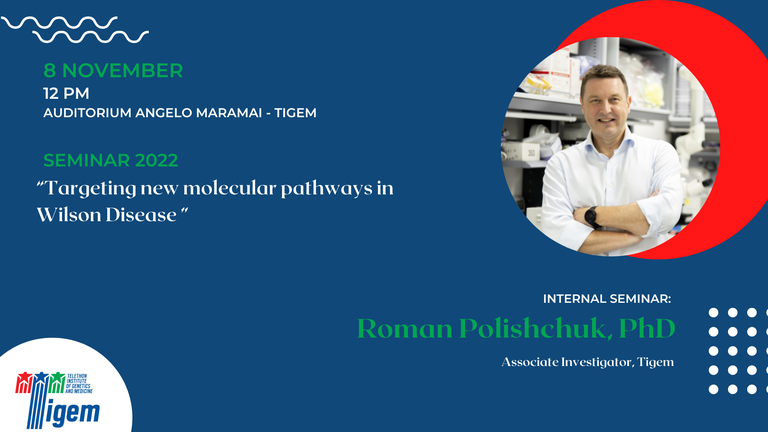Roman Polishchuk, PhD - "Targeting new molecular pathways in Wilson Disease"
- What seminar
- When Nov 08, 2022 from 12:00 PM to 01:15 PM (Europe/Berlin / UTC100)
- Where Tigem Auditorium Vesuvius
- Contact Name Roman Polishchuk
- Contact Phone 08119230659
-
Add event to calendar
iCal

- https://www.tigem.it/newsroom/seminars/roman-polishchuk-phd
- Roman Polishchuk, PhD - "Targeting new molecular pathways in Wilson Disease"
- 2022-11-08T12:00:00+01:00
- 2022-11-08T13:15:00+01:00
Abstract
The trace metal copper is an essential micronutrient since it operates as a cofactor for a variety of enzymes driving vitally important biological processes. However, copper is extremely toxic when present in excessive amounts. Therefore, uptake, distribution and consumption of this metal require the tightly regulated interplay of membrane trafficking, ion transport, and quality control mechanisms. Disruption of such mechanisms results in severe phenotypes that are observed in patients with inherited disorders of copper metabolism.
One such disorder, Wilson Disease (WD), is caused by mutations in the gene encoding the hepatic copper transporter ATP7B and leads to toxic accumulation of copper (Cu) in the liver and in the brain with the development of severe hepatic, neurological and psychiatric symptoms. Approved therapeutic strategies for WD are restricted to reducing copper absorption or Cu chelation. Although effective, these treatments have serious side effects or limited efficacy in a large cohort of patients. Therefore, there is an unmet need to find alternative therapeutic options.
Over the last decade, several research lines in my lab have been directed towards identifying the molecular and cellular mechanisms which drive the pathogenesis of WD that might be targeted for development of novel therapeutic approaches. In my talk I will focus on a couple of these mechanisms. The first addresses the retention and degradation of misfolded ATP7B variants in the endoplasmic reticulum (ER). By targeting specific components of the ER quality control, we circumvented ER retention/degradation of the ATP7B mutant proteins, rescued their trafficking and function, and thereby reduced copper toxicity in hepatic cells, including those derived from patients. The second mechanism relies on ability of prion protein (PrP) to bind extracellular copper and to promote its uptake. We found that pharmacological or genetic suppression of PrP significantly improved tolerance of ATP7B-deficient cells to copper and, therefore, could be explored as a potential therapeutic tool for WD.
